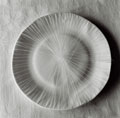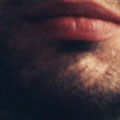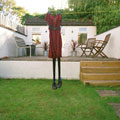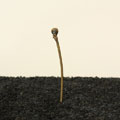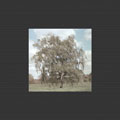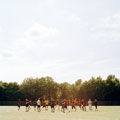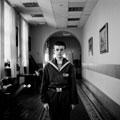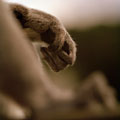THE TASTE OF WATER 2 1
Mark Durden
2011
In one of his later essays, on Ansel Adams and published in 2001, John Szarkowski— the former head of the photography department at New York's Museum of Modern Art, and one of the most powerful figures in photography— said how: "The simplest and most common experience— the taste of water, let us say— has not yet been communicated in words or pictures, and most of us do not expect this breakthrough soon. Yet we might agree that our arts are at bottom an effort to do this— to give objective form not to our ideas but to our visceral knowledge." Giving form to experience, our visceral knowledge, was integral to what Szarkowski valued as good photography. We can, he says, again in his essay on Adams, "describe an idea more precisely than an experience."
Szarkowski, as his writings make clear, championed a certain kind of photography— fit for purpose, un-embellished, non arty. Walker Evans's photographs, straight, unassuming, preoccupied with the commonplace and vernacular, were of key importance to the curator and in many sense define his taste; for all curators are partial and partisan, no matter how powerful their position. Szarkowski valued photography in distinction from painting (Pictorialism was anathema), illustrative commercial photography and also, importantly, in distinction from the documentary tradition. In an interview in the mid 1980s, Szarkowski spoke about how he thought the documentary tradition had become "leaden" and "boring" by the 1960s. Documentary was dismissively likened to "sloganeering". Such a stance explains why at the heart of the political turbulence of the events of the 1960s in the USA, Szarkowski's 1967 MoMA show, New Documents, offered in its place the work of three relatively unknown photographers (Lee Friedlander, Diane Arbus and Garry Winogrand), work that looked not simply outside but also drew from the world within. Arbus's pictures, as he later said, were a more powerful register of the psychic shock of Vietnam than its best photoreportage. Winogrand's 1977 MoMA show, Public Relations, described how media impacted upon events— a series of detached and wry observations of people amidst rallies, marches, protests and parties. Such pictures of news events were without the clear rhetoric and message-bound characteristic of news photographs. Instead, many of his pictures responded to the human situations and behaviours that remained apart and separate from their orchestration and choreography as legible media events— Winogrand's brilliant 1969 photograph, for example, showing that over self-satisfied smile on the face of Mayor John Lindsay, sitting on a bench in Central Park, surrounded by both press and adulators.
Szarkowski's critique of message-driven and idea rather than experience-led photography has value and relevance. Especially when it is considered in relation to photography's current and continued devaluation as a picture within social media. Photography lends itself to printed matter, it appears close to writing and text, but it is different and distinct. Within social media, the photographic image, reduced in size and distributed with speed, becomes primarily a communicative and message-driven form. It is no longer as a medium in the modernist sense that we begin to understand photography through reading Szarkowski— a medium as a unique and distinctive picture form, which looks and behaves in a certain way. Photography instead has itself become a medium in the sense of something through which things pass, the medium understood as a carrier, a conduit. It was this very reduction that Susan Sontag had presciently realised in her essays from the 1970s, collected together in her 1977 book On Photography. Photography was for her not art because it was a medium, it reproduced art and it obliterated art in the process, making it part of mass media.
The digital has signalled not the death but the expansion of photography, photographic image forms are more pervasive, they now saturate both public and private spaces, from billboard to smart phone. In this climate, contemporary photography can take two paths— either mirror that image culture, mime its language and forms, or proffer something different to it. And here we are back to the difficulty Szarkowski's quote presented us with at the outset: how such a simple and common experience as the taste of water has not yet been communicated in literature or art. But this nevertheless seems to be the greater and more exciting challenge today— to make photographs that come closer to the wildness, illegibility and contradictory realm of our "visceral knowledge".
‘HEY,YOU THERE!’ 2 1
Paul Tebbs
Following the protests in Europe in 1968, the philosopher Louis Althusser wrote a short text entitled 'On Ideology' in which he argues that various Ideological State Apparatus (for example the church, the political system, and culture) function to generate a human subject who willingly accepts their subjection and economic exploitation. Their willingness to be subjected arises seemingly naturally within them. (The recent rise in protest across the world has seen a re-examination of Althusser's thought).
In a fascinating section of the book, Althusser equates the ideological interpellation of the subject with the act of hailing. He states, '...the hailed individual will turn round. By this mere one- hundred and eighty degree physical conversion, he becomes a subject....[he] turns around, believing/suspecting/knowing that it is for him, i.e. recognising that 'it really is he' who is meant by the hailing...The existence of ideology and the hailing or interpellation of individuals as subjects are one and the same thing.'
How do we understand this 'turn round'? What do we move from and to in this 180o turn? What is the difference between turning away and turning towards your beckoner? And who might the un-hailed be? And what does a counter-hail look and feel like? It should be stressed that we are hailed in many different ways, not least by and through images. The history of photography's agency within the politics of 'hailing' is certainly complex, and at times one must say, dark.
Art and politics are similar in that both are often concerned with a struggle for recognition. The desire for recognition being so essential to being human, that, according to Hegel, everyone will risk their life to obtain it. But we don't need a philosopher to tell us this. Many of the works presented here are concerned with recognition. Recognition being, one might argue, of a different order and temporality within subject formation to 'hailing'. What each student on this Photography MA brings to photography is a mode of personal search, through which, both recognition and a mode of visual hailing are potentially manifest. Indeed, 'Hey, you there!'











